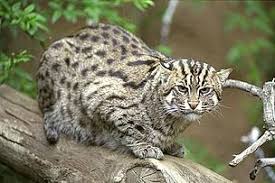Pakistan has long struggled with the gradual disappearance of its rare wildlife species due to a deadly mix of environmental and human induced factors, including habitat destruction, dwindling water resources, pollution and poaching.
Among these vanishing species is the endangered Indus fish cat, mostly found in the Indus River Delta and the surrounding buffer areas, where its number has fallen dramatically in recent decades.
Habitatics, food button, hunting and growing human populations have affected this rare cats, playing an important role in maintaining the balance between aquatic ecosystems, according to experts.
“The last two decades have seemed disastrous to this environmentally friendly animal, mainly because of the destruction of wetlands and killings from the locals,” Saeed-UL-Islam, a senior Pakistani wildlife expert, told Anadolu.
Although official investigations have not yet determined accurate figures, Islam explained that conservative estimates suggest that the cat’s population in Pakistan has fallen by more than 50% in the last two decades alone.
Globally, the fishing catpopulation has fallen approx. 30% since 2010, and the animal has been listed as vulnerable to the International Union for Conservation of Nature (IUCN )’s red list since 2016.
In addition to reducing the water level, worsening water quality has worsened the situation of these animals.
“Disharging water quality due to untreated water flowing directly into water masses and the use of pesticides and chemical fertilizers also takes a toll on conservation efforts,” noted Islam.
The region’s last surviving predator
Wildlife specialists consider the fishing cat the last surviving large predator in the Indus flood plains after the almost extinction of others such as Gharials, Tigers and Leopards of the region.
“We have this last predator in the Indus flood plains, which greatly helps keep aquatic animal populations healthy,” said Zafeer Ahmed Shaikh, head of Indus Fishing Cat Project (IFCP).
IFCP, launched in 2021, constitutes part of the Global Fishing Cat Conservation Alliance Initiative that seeks to protect and preserve this rare species. The project engages communities, state authorities and wildlife organizations to support conservation efforts.
Before 2020, the status of Indus Fishing Cat remained on Pakistan’s IUCN Land List uncertain, which suggested that the species was approaching extinction, according to Shaikh.
“It was the United States (IFCP) that told the world that this animal not only exists in Pakistan, but that its distribution area has been expanded to the river areas of Sindh and Balochistan provinces through the canal network,” Shakh claimed.
In addition to the Indus Delta, the recent observations have taken place in Jaffarabad and Jhal Magsi districts in southwestern Balochistan province.
Challenges in determining accurate numbers
Shaikh recognized the difficulty of determining the exact population numbers due to lack of comprehensive studies from either state agencies or wildlife groups.
“We can’t give a specific number about its population in Pakistan. But one thing is safe – its number has been reduced due to shrinking wetlands and bodies of water,” he said.
“Therefore, it is difficult to solve its current status, but it can certainly be described as” almost threatened “considering the circumstances given.”
Shaikh acknowledged that although IFCP has made “a small difference” to increase the fishing cat’s numbers, “it is a long way to go.”
Kamal Palari, a community worker involved in IFCP conservation efforts in Sindh’s Thatta district, noted a significant reduction in hunting events involving the fish cat in recent years.
“The locals, especially farmers, would kill them because they mistakenly thought this cat was a threat to their livestock and crops,” Palari told Anadolu.
However, he said that attention campaigns launched by IFCP and increased societal involvement have led to a noticeable decrease in such cases.
Shaikh also clarified that the fish cat “very rarely” attacks goats and has no capacity to threaten livestock herds significantly.
Balancing of aquatic ecosystems
Mumtaz Soomro, a Deputy CEO of Sindh Wildlife Department, believes that strict laws of wildlife protection, adopted in 2020 – introducing heavy fines and judgments for rare species hunt – have further helped reduce the killing of fishing cats.
Soomro said the department has collaborated with communities and wildlife groups on consciousness campaigns to protect the cat, which he emphasized is “very important to keep sea life healthy.”
“We have already almost lost leopards, tigers and other predators due to human-induced factors. We cannot afford to lose this last predator,” he said.
In addition to shrinking wetlands, Islam cited the overfishing of local communities as another critical reason for food shortages affecting the fish cat.
He also emphasized the important role of fishing cat in maintaining the ecological balance of the Indus Delta.
“The fishing cat is a species of low -lying wetlands and can not only survive on fish, but also on supplementary foods such as crabs, rodents and birds. The cat only catches lazy animals and fish, which helps maintain health in the remaining aquatic life,” explained Islam.
Shaikh repeated these views and emphasized the role of the fishing cat in protecting crops by controlling populations of rodents and turtles.
“They control the population of small animals so that the ecosystem remains in balance,” he concluded.



